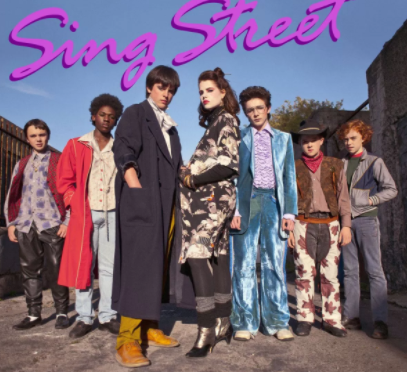The Irish maestro of interweaving stunning songs into film (see: Once and Begin Again), John Carney, disappoints not with his latest feature, Sing Street. A heartrending coming of age tale of one Dubliner teen’s struggle to accept that not everything can return to normal at the end of the proverbial half hour, our lens into Conor Lawlor’s (Ferdia Walsh-Peelo) world begins with a 1985 news report about the mass exodus of Irish people to London in search of job opportunities that simply don’t exist in Ireland. This proves no exception to the struggles affecting Conor’s own family.
Sitting at the dinner table with his father, Robert (Aidan Gillen), his mother, Penny (Maria Doyle Kennedy), his brother, Brendan (Jack Reynor), and his sister, Ann (Kelly Thornton), Robert diverts the family’s attention away from the news to tell Conor that the only thing left for them to cut costs on is his privately paid for education, and that he’ll now be attending the state paid for school closest to them, Synge Street Christian Brothers School. Horrified at the prospect, he looks to Brendan, his mentor and musical guru, for comfort. All Brendan can do, however is feel assured in his decision to not have bothered finishing his own higher learning.
Upon commencing his first day at Synge Street, the contrast is immediately apparent to Conor, whose “posh” look and manner of speaking brings out the ire of requisite school bully, Barry (Ian Kenny), lusting for fresh meat to toy with. To compound his torment, Conor must also contend with the headmaster, Brother Baxter (Don Wycherley), a stodgy old school bloke that would prompt Morrissey to write a sequel to the “The Headmaster Ritual.”
Darren (Ben Carolan), a red-haired boy also on the fringe, mercifully takes a shine to Conor, and is the first one to call his attention to Raphina (Lucy Boynton), a moody but beautiful girl who doesn’t bother with frivolities like school, instead choosing to focus on her modeling career by constantly posing on a stoop and ultimately planning her escape to London. Bold enough to approach her, it’s in this moment that Conor decides he’s got to be in a band if he’s going to have a reason to speak with her again. After all, if his band’s making a music video, they’ll need a model for it. When she buys his line and gives him her number, he rushes urgently back to Darren to tell him they need to get to work.
Luckily, Darren can point him in the direction of a rabbit-obsessed, multi-talented instrumentalist named Eamon (Mark McKenna), who is the first piece of the puzzle in forming Sing Street. It is Eamon who suggests they need to find a black person for their band, which means infiltrating the estates (as they’re called more euphemistically in Anglican culture, instead of projects) and initially speaking to Ngig (Percy Chamburuka) like he’s mildly retarded, only to have him say, “You know I’m from here, right?” in a cheeky Irish brogue. After putting up a flier at their school and procuring two more band members, the complete formation of Sing Street is put into place.
Under Brendan’s tutelage and an absorption of a detailed analysis of Duran Duran’s “Rio” music video, Conor–now rebranded to Cosmo–begins practicing a cover of, what else, “Rio.” When he presents the tape recording to his brother, Brendan promptly criticizes it and tells him, “That was bad. And there’s nothing as bad in this world as bad music.” He then brings Cosmo back to what’s really important–the entire reason for Sing Street’s existence: “It’s all about the girl, isn’t it? And you’re gonna use somebody else’s art to get to her? Are you kidding?”
And so, with Brendan’s vehement encouragement, Cosmo writes his first song expressly with Raphina in mind. Titled “The Riddle of the Model,” Cosmo goes over the lyrics with Eamon, McCartney/Lennon style, reciting: “She’s standing on the corner like an angel in disguise/I want to try and warn her, she’s got dangerous eyes.”
Once the song is completed, Cosmo urgently gives the tape to Raphina and tells her where to meet the band on Saturday. So commences the group’s many video collaborations tailored solely to use of Raphina as the star. While their sound is constantly evolving based on whatever record Cosmo is studying at the moment (all listening assigned by Brendan, naturally), their visual accompaniments always mirror the style of music. For instance, after listening to The Cure to fulfill Raphina’s request of creating music that’s “happy-sad,” Sing Street takes to the water to film a video of Cosmo jumping in to save Raphina. The point being, the visual element, for them, is just as important as the auditory–this being Carney’s statement on how the 80s made music an ocular medium.
In spite of Cosmo’s undistilled love for Raphina, like all blokes–especially musicians–his idealization wanes over time, giving way to something purer, though much less romanticized. As he himself remarks to Eamon, “It’s like when you don’t know someone, they’re more interesting. They can be anything you want them to be. But once you know them, there’s limits to them.” And the limits to Raphina are many, chief among them being that she’s probably not going to stick around Dublin and put off her plans to leave with her older boyfriend for London just because she has a regular unpaid gig as a video star, and a fervent admirer in Cosmo. But then, isn’t heartbreak the greatest of inspiration to any artist?






















